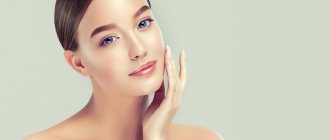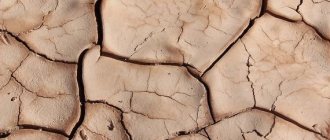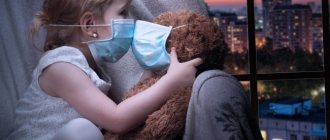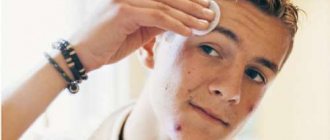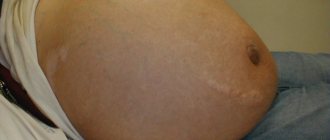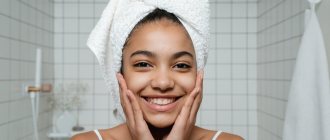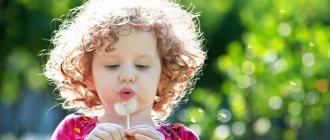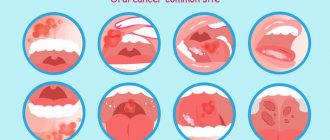Causes of facial allergies
Atypical reactions of the immune system to foods, chemicals and biological substances can cause rashes, pimples, redness, swelling and itching. The person experiences physical and moral discomfort. The manifestations of allergic reactions are varied and depend on the individual characteristics of the body. Most often, localization is observed on the forehead, temples, cheeks, behind the ears, in the décolleté area and on the neck. The most common prerequisites for allergies are:
- heredity;
- consequences of long-term use of medications;
- unfavorable environment;
- constant stress;
- reduced immunity;
- too high a concentration of certain substances;
- insect bites;
- cold or direct sunlight.
There may be other reasons; you need to approach the problem individually.
Allergies to foods and medications
There is often cross-reaction to the protein in this group, making it difficult to find the source. The speed of onset of symptoms can vary from immediate to a period of 2-3 hours. In the case of medications, the prerequisite is overdose, long-term use, too many drugs taken during the day.
Sun or cold
The body’s response is characteristic not only of winter. This could be water or food at a certain temperature. The appearance of photodermatitis is promoted by internal and external causes. Within a day or a little later after exposure to the sun, soreness and itching of the skin begin to bother. When an allergic rash appears on the face of an adult, treatment should begin immediately, otherwise the situation will worsen with each passing hour. As part of complex therapy, immunostimulating cosmetics such as Laennec are effective. Before use, you should consult with specialists.
Reaction due to eczema
Skin diseases significantly reduce the body's resistance, and any violation provokes their exacerbation. Most often, the reaction appears externally in the form of small bubbles with liquid. The acute form can become chronic, which subsequently leads to relapses.
Errors in diet
Various dietary restrictions do not go out of fashion. There are programs based on the consumption of one or just a few products for a long time, which leads to an oversaturation of the body with certain elements, since in this case there can be no talk of balance. You should not be surprised at the deterioration in well-being, since such restrictions become the causes of severe allergies on the face of an adult, the treatment of which is carried out comprehensively and will take a lot of time.
We recommend
GHC Placental 3D Mask withQ10
Serum concentrate
Repairing cream with a moisturizing effect
Placental antioxidant lotion concentrate
Contact with animals, insect bites
A swollen nose and watery eyes when trying to pet a pet are a true classic of the genre. Mosquitoes, bedbugs and other blood-sucking creatures can also cause itching and redness on the skin. The toxins they inject in large quantities cause a rash, often accompanied by fever. In this case, external agents and antihistamines are recommended; dosages should be confirmed with a doctor.
Allergies due to stress
In addition to nervous tics, there are other reactions to emotional overload. Unconsciously, a person may scratch or clench their hands tightly. If such situations happen regularly, then health problems may begin. Itching, swelling of certain areas, redness, and difficulty breathing appear. The main direction of stabilizing the condition is the prescription of sedatives, breathing exercises aimed at calming the nervous system, ointments and gels to relieve external manifestations on the skin.
Rash caused by diseases of the blood and blood vessels
A rash due to diseases of the blood or blood vessels is caused by damage to the walls of the capillaries, as a result of which petechiae - small bright red dots - appear on the surface of the skin. Unlike ordinary hemorrhages, a rash due to blood diseases does not change color when pressed. Other signs indicate the disease:
- joint pain (knees, ankles);
- black stools, diarrhea, sharp pain in the abdomen as if poisoned;
- the rash covers the entire body.
Diseases that cause hemorrhagic rash include:
Idiopathic thrombocytopenic purpura (Werlhof's disease) is a blood disease in which small arteries and capillaries are blocked by blood clots. Mainly found in children, especially newborns. The disease has autoimmune causes of unknown etymology. Those. Your own immune cells perceive platelets as a foreign body and attack them. The rash is painless, occurs as a reaction to the administration of any medication, and is localized at the injection site.
Hemoblastosis. This is a malignant tumor that occurs very often in childhood. The rash has several types:
- hemispheres of red-brown color, covered with a crust;
- blisters with serous fluid inside;
- rashes similar to bruises, both large in size and in the form of bloody dots that appear without any reason.
In all cases, the rash causes severe itching. Blood tests for hemoblastosis show a significant increase in the number of leukocytes due to decreased immunity. Hemoglobin drops, lymph nodes enlarge. Platelet counts drop and the child gets tired quickly. The main cause of rash in diseases of the blood or blood vessels is a decrease in the number of platelets and a disruption in the synthesis of proteins involved in blood clot formation. This rash also occurs when taking medications that thin the blood (Aspirin, Warfarin, Heparin).
Diabetic angiopathy. This is a violation of the vascular capacity of the lower extremities, provoked by type 1 and type 2 diabetes mellitus. Due to the disease, the walls of blood vessels become thinner and become fragile. This causes skin dystrophy. Ulcers and erosions appear on the skin.
Types of allergies on the face
If in children the most vulnerable area is the buttocks, where signs appear that indicate certain foods or unfavorable conditions, then in adults this is the nasolabial triangle, eyelids, lips, tongue, neck and hands.
Atopic dermatitis
Chronic inflammatory skin disease. Most often begins in early childhood. The priority prerequisite is genetic predisposition. It can be a concomitant disorder with bronchial asthma and conjunctivitis. There are infant, child and adult forms of the disease.
Hives
Allergies and rashes in the form of pimples on the face, the photo of which most often appears on advertising posters of the newest antihistamines, occurs with a seasonal variant. It is characterized by lacrimation, swelling of the eyelids, obsessive itching, and redness of certain areas of the body.
Food reactions can occur instantly when certain foods enter the mouth and esophagus. Most often they are milk, eggs, red or yellow fruits, and nuts. Peanuts are the most dangerous in this regard.
Contact dermatitis
Recognizable by clear zones of irritation. The causes are hygiene and cosmetic products, chemicals that come into contact with unprotected skin, jewelry, piercings, latex products, extracts and juices of certain plants. It manifests itself in the form of weeping erosions, in place of which dry scales then appear. To understand how to remove facial allergies, you need to find and eliminate the substance that causes your health to worsen. Often a good result comes from moving to another region. This way, it is possible to cut off some of the options; for the rest, you will have to take special tests in the laboratory.
Toxicoderma
A distinctive point is inflammation not due to external factors, but due to the penetration of a provoking substance into the body. In some cases, it can cause secondary damage to internal organs and anaphylactic shock, since it develops rapidly from the ingestion of an allergen from the inside. One way to prevent inflammation is to take antibiotics, especially penicillin. At the same time, timely treatment gives good results.
The alimentary variety is included in a special group; the deterioration of the condition is provoked not by products, but by food additives in their composition. It is quite dangerous due to the fact that it can occur suddenly, since manufacturers do not indicate all the ingredients in the composition.
Quincke's edema
It poses a direct threat to life. In the question of what an allergy on the face and neck looks like in this case, what to do and how to treat it, time is of the essence. Choking occurs quickly, and the slightest delay can have fatal consequences. An acute inflammatory reaction of the body, which occurs locally in the skin and subcutaneous tissue, affects deep layers, including the muscles of the respiratory system, and in a third of cases is localized in the larynx. It is impossible to prevent the development of Quincke's edema. Women suffer from this disorder more often. The diagnosis is made based on the clinical picture and requires medical attention. Signs may persist for several days and disappear gradually. Treatment includes the administration of potent antiallergic drugs. In severe cases, the patient requires urgent hospitalization in an intensive care unit or intensive care unit.
Topical retinoids (adapalene)
In fact, this is the most important ointment for acne on the face. Topical retinoids are intended for external use. Such drugs are prescribed - 1) for the comedonal form of acne, which means acne, 2) for the papulopustular form of acne (i.e. in the presence of pimples). Previously, the topical retinoid tretinoin was used to treat acne, but it had a lot of side effects, and now there are much safer 4th generation topical retinoids, for example, adapalene.
Such drugs are monocomponent and combined. Monopreparations based on adapalene include Differin, Klenzit or Adaklin. A number of drugs of this type are produced only in the form of gels, but some manufacturers produce drugs with adapalene in both gel and cream form. Gel products will be more effective, but facial acne cream is more suitable for patients with dry and/or sensitive skin (and will help reduce the risk of irritation in such patients).
Examples of combination drugs with retinoids are 1) Klenzit-S, containing adapalene together with the antibiotic clindamycin, 2) Effezel, containing adapalene in combination with benzoyl peroxide. The choice of drug will depend on the severity of the acne, as well as on which inflammatory elements predominate in you (papules or pustules). All this information is schematically reflected in Table 1, which we placed before the description of groups of drugs for the treatment of acne.
How to treat facial acne with retinoids:
- Preparations containing adapalene should be used once a day before bedtime. Before applying a retinoid, you should wash your face with a mild cleanser. Before applying the retinoid, the skin must be completely dry, because... otherwise severe irritation will develop. To get your skin used to it and not be too irritated, start using the drug 3 times a week. After 1-2 weeks, switch to daily use.
When can you expect results: skin oiliness decreases sharply within a few days from the first use. As for acne and pimples, the first noticeable result can be seen only after about 4 weeks of therapy. Good results can be seen after about 8 weeks of using retinoids, but for radical improvement a full course is required, which lasts at least 12 weeks (3 months).
Use of oral retinoids:
In addition to topical retinoids intended for external use, there are also so-called systemic retinoids for oral administration. Such drugs (Acnecutane or Roaccutane) contain the retinoid isotretinoin. These drugs are very effective for treating acne, but they also have very serious side effects. Therefore, such drugs are used only in difficult situations, for example, for the treatment of nodular and conglobate forms of acne.
Use of oral contraceptives in women:
As for the use of oral contraceptives in women, you can read more about this method of treatment in the article at the link below:
→ Oral contraceptives for acne in women
What does an allergy look like on the face?
There are many manifestations of allergies, and they depend on the form, location and intensity. The main indicator of the disorder is sudden swelling of the eyes and lips, one or both. Changes also affect the structure of the skin. It becomes lumpy, swollen, with a small scattering of small dots. Red, uneven spots of varying sizes often appear. Cracks and a scaly structure may be observed. If you give in to temptation and start scratching the itchy areas, the condition will quickly worsen.
Depending on the type of disorder and the affected area, allergic rashes on the face are likely, the treatment of which requires an integrated approach. Along with pharmaceutical drugs, cosmetics have a fairly good effect. Plasma therapy with the Japanese drug CURACEN perfectly restores appearance, but only after the acute period ends and the condition stabilizes.
Rashes due to intestinal diseases
If the contents of the intestines are poorly removed from the body, then some of the toxins will begin to penetrate into the blood. The body begins to get rid of poisons itself through the excretory system. Because of this, the condition of the skin worsens, and it becomes characteristic of:
- increased fat content
- dull complexion
- acne, not only on the face, but also on the back, stomach, chest
- noticeable “black dots” similar to volcanic craters
- skin becomes dry and dehydrated
- After acne heals, scars remain.
After the New Year holidays, many people note a deterioration in their skin condition and notice minor rashes that go away on their own. They are associated with contamination of the body with toxins caused by eating large amounts of heavy food.
How to diagnose allergies
The main difficulty is to distinguish it from a skin disease. Rashes should not be a reason for panic, but a prerequisite for examination. To prevent exacerbation and speed up the process of identifying causes, it is necessary:
- try to independently identify the allergen by eliminating cosmetics or products from everyday use, doing this gradually in order to replace the changes in time;
- take an antihistamine that has already been used as prescribed by a doctor;
- Remove all alcohol-based external care products from use.
After such measures, it will be much easier to determine how to relieve an allergic reaction on the face and alleviate the general condition.
We recommend
GHC Placental 3D Mask withQ10
Serum concentrate
Repairing cream with a moisturizing effect
Placental antioxidant lotion concentrate
Nervous rash
Stress and nervous tension often cause skin rashes. Under the influence of a stressful situation, the immune system is suppressed. The body spends its resources to maintain the normal state of internal organs. For this reason, previously hidden diseases worsen. Also, weakened immunity provokes urticaria - a small rash similar to the reaction of the epidermis to the touch of nettles. This pathology is otherwise called nervous eczema. It, unlike a normal allergic reaction, is accompanied by the following symptoms:
- severe itching that is not relieved by antihistamines
- pulse quickens, hand tremors are felt
- restless sleep, night sweats
- panic attacks, feelings of anxiety and danger
- swelling of the face and limbs.
Typically, nervous eczema occurs after a traumatic situation or severe stress. Treating skin rashes with creams or medications does not help. Improvement comes only after the life situation normalizes. Itchy urticaria due to nervousness can be soothed by baths with sea salt, which also have a good effect on the nervous system.
Treatment
It is not recommended to use drugs other than antihistamines on your own. In most cases, they are enough to eliminate the main symptoms and relieve swelling. It is necessary to take into account that the action must be comprehensive and must include creams, ointments and gels to relieve external signs of the disease.
Preparations for internal use
Medicines prescribed by a doctor are divided into corticosteroid and non-hormonal. The first are produced on a hormonal basis, have a powerful effect, but have a number of serious contraindications for long-term use. The second, milder ones, are prescribed to relieve mild forms of irritation. Several generations of antihistamines are available in pharmacies. If the former, such as Suprastin, influenced the level of attention, causing drowsiness and inhibition of reactions, then Cetrin, Telfast, Claritin, with high efficiency, do not give side effects that could become a limitation for work in areas where concentration is required.
Cosmeceuticals and their help in the fight against allergies
When the body reacts violently to a stimulus, skin lesions are sure to appear, and sometimes quite unpleasant ones. These are not only rashes and pimples, but also increased dryness and microcracks. Their danger lies in the possible entry of bacteria and the development of local inflammation. The main task, along with eliminating illness, is strengthening the immune system. Cosmetic products from the medical corporation "RHANA" are used in professional problem solving, provide a quick and lasting positive effect, allowing you to maintain beauty, health and prevent premature aging. And the skin is susceptible to it if an allergic reaction often appears on the face, a photo of which clearly demonstrates the degree of damage to the integument.
In order to give a fresh look and ensure cellular renewal, it is recommended to use placental preparations:
- Modeling mask with placenta hydrolyzate GHC Placental 3D Mask withQ10. It will prevent the risk of developing inflammation and give a healthy tone.
- Concentrate serum for intensive revitalization GHC Essence will instantly restore inner radiance, and also improve microcirculation and cell nutrition.
- LNC Repairing Cream with a moisturizing effect will preserve the beauty and freshness of the skin, and also protect it from moisture loss and eliminate the regeneration of ceramides (epidermal cells).
- Placental antioxidant lotion concentrate LNC Toning Lotion will protect cells, normalize melanin production and provide optimal hydration.
The dangers of self-medication
According to preliminary forecasts, the number of people reacting to certain stimuli will reach almost 90% by the end of the century. Allergists-immunologists mention the fault of allergy sufferers themselves, who, by self-medicating, expand the range of allergens and provoke the development of other diseases. In this case, the part is fixed and passed on by inheritance. By identifying the cause and drawing up an optimal treatment regimen, you can almost completely eliminate the likelihood of regular exacerbation of allergies.
Phototherapy and lasers for acne treatment
Phototherapy and lasers are used to treat acne - either endogenous porphyrins contained in P. acnes, or sources of exogenous porphyrins are additionally applied to the skin before the procedure. Porphyrins have the property of absorbing light in the blue regions of the spectrum (wavelength 415 nm), which leads to the formation of unstable oxygen and, as a result, to the destruction of pathogenic bacteria P.acnes. The FDA recommends Lumenis devices (for example, the IPL module of the M-22 device), which use high-intensity light from the blue part of the spectrum, for the treatment of papulopustular acne, i.e. acne.
Light from the red part of the spectrum can also be useful because... Compared to blue light, it has a stronger anti-inflammatory effect (although it has a lesser effect on porphyrins). Therefore, a combination of light from the blue and red parts of the spectrum will be even more useful. Facial procedures are carried out 2 times a week for 15 minutes. According to the dermatology textbook Fitzpatrick's Dermatology, after a 4-week course of therapy in 80% of patients, the number of acne decreased by 60%. But in the absence of supporting procedures, their number returns to the original level - within 3-6 months.
Photodynamic therapy is even more effective in treating acne. It consists of applying exogenous porphyrins to the skin 1 hour before the procedure (aminolevulinic acid/ALA), after which exposure to a high-power light source occurs. The latter can be pulsed dye lasers, intense pulsed light or a broadband light source in the red part of the spectrum. ALA is metabolized in the sebaceous glands and hair follicle to porphyrins, which when exposed to light lead to the release of unstable oxygen, which damages the sebaceous glands. Several photodynamic therapy treatments can provide improvement for up to 5 months.
Pulsed KTP laser (wavelength 532 nm) - also leads to a reduction in the number of acne by about 40%. Use this laser 2 times a week for 2 weeks (a total of 4 treatments are required). In addition, some of the non-ablative infrared lasers at 1450 nm and 1320 nm wavelengths may also be useful for treating acne. they cause thermal damage to the sebaceous glands. However, any of these lasers requires a course of several treatments (and the improvement lasts up to about 6 months).
One of the newest acne treatment devices is the Isolaz device (from Solta Medical). The nozzle of the device is made in the form of a photo-pneumatic device, which creates negative pressure that sucks out the fatty secretion from the mouths of the hair follicles. Immediately after this, broadband pulsed light (wavelength from 400 to 1200 nm) is turned on, which acts on the P. acnes porphyrins, destroying these bacteria, and also has an anti-inflammatory effect.
What do phototherapy and lasers do?
Regular use in courses not only improves the course of acne, thereby reducing the number of inflammatory elements. The use of phototherapy (IPL) and lasers in courses often avoids the need for oral medications (antibiotics, isotretinoin), as well as the numerous side effects associated with them. But the cost of such treatment is high. We hope that our article on the topic: How to remove acne on your face was useful to you!
Sources:
1. Higher medical education of the author of the article, 2. Textbook on dermatology “Fitzpatrick's Dermatology” (8th edition), 3. “Modern methods of treatment and rehabilitation of patients with acne vulgaris” (Barinova), 4. “Acne from the position of evidence-based medicine” (Anisimova), 5. “Cellular mechanisms of barrier protective functions of the skin and their disorders in skin diseases” (Medelets).
Preventive measures
In order not to look with disappointment at your reflection in the mirror and not to wonder how to get rid of allergies on your face once again, you should listen to the simple but effective advice of specialists.
- Adjust the daily menu by removing from the diet foods that provoke the appearance of characteristic symptoms of an immune disorder.
- Do not use cosmetics based on alcohol and other aggressive substances, giving preference to soft and neutral ones.
- Do not stay in the sun for a long time, and in winter, protect your skin from the cold as much as possible.
- During seasonal exacerbations of hay fever, use inhaled isotonic saline solutions to reduce the concentration of pollen in the nasopharynx.
- Always keep in your medicine cabinet an antihistamine recommended by an allergist-immunologist.
It is worth remembering that angioedema alone cannot be prevented. Other types of allergies are completely preventable, and this is much more effective than constantly treating exacerbations. Immunity support should take the leading place in the list of mandatory activities.
Why are allergies on the face dangerous?
A scattering of small specks or red spots not only look unsightly, but also pose a hidden threat. Acute inflammation, accompanied by swelling, can spread to the neck and make breathing difficult.
Violation of the structure of the skin, accompanied by a feeling of tightness, reduces the natural resistance to external influences. Weeping areas, as well as cracks in the upper layer of the epidermis, create a favorable environment for the proliferation of pathogenic bacteria, which leads to the appearance of pimples and ulcers. When such a condition occurs and is not treated, there is a high probability of it becoming chronic. In addition, an unpresentable appearance can cause a sensitive blow to pride and cause problems in communication.
If an allergic rash appears on the face, a specialist from a clinic or health center will tell you how to treat it. It is better to contact him at the first signs in order to make a timely diagnosis and receive an effective treatment regimen to avoid complications.
Squeezing pimples and blackheads (comedone extraction)
For comedonal and papulopustular forms of acne, invasive methods are sometimes used, for example, comedonal extraction. Extraction means their removal/squeezing out - using special comedones extractor tools, or by palpation. Moreover, we are talking about the removal of macrocomedones, i.e. large eels. But squeezing out pimples (papules and pustules) can, at best, lead to the appearance of a hyperpigmented spot in this area in the future.
In the worst case, self-squeezing pimples and blackheads can lead to the spread of inflammation and the formation of deep subcutaneous pimples, which will leave superficial or deep atrophic scars on the skin. Therefore, only comedones (acne) can be squeezed out, and secondly, this should only be done by a dermatologist or a dermato-cosmetologist. The procedure is called “mechanical facial cleansing.”
Mechanical facial cleansing: video
Important: keep in mind that the removal of comedones is much easier and without complications if the patient has previously used topical retinoids for at least 3-4 weeks. The fact is that topical retinoids (adapalene) also have comedonolytic properties.
